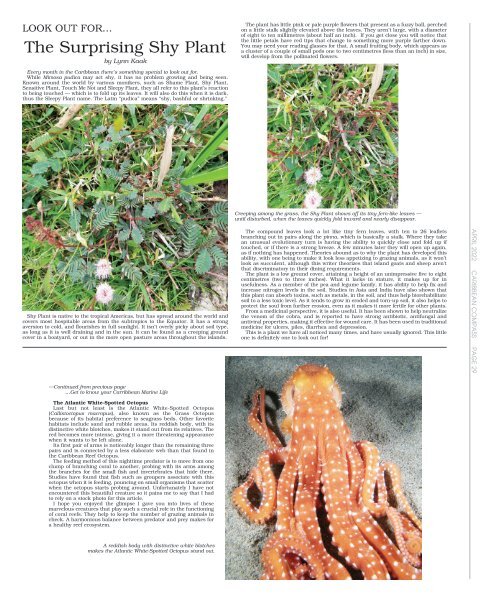Caribbean Compass Yachting Magazine - April 2022
Welcome to Caribbean Compass, the most widely-read boating publication in the Caribbean! THE MOST NEWS YOU CAN USE - feature articles on cruising destinations, regattas, environment, events...
Welcome to Caribbean Compass, the most widely-read boating publication in the Caribbean! THE MOST NEWS YOU CAN USE - feature articles on cruising destinations, regattas, environment, events...
Create successful ePaper yourself
Turn your PDF publications into a flip-book with our unique Google optimized e-Paper software.
LOOK OUT FOR…<br />
The Surprising Shy Plant<br />
by Lynn Kaak<br />
Every month in the <strong>Caribbean</strong> there’s something special to look out for.<br />
While Mimosa pudica may act shy, it has no problem growing and being seen.<br />
Known around the world by various monikers, such as Shame Plant, Shy Plant,<br />
Sensitive Plant, Touch Me Not and Sleepy Plant, they all refer to this plant’s reaction<br />
to being touched — which is to fold up its leaves. It will also do this when it is dark,<br />
thus the Sleepy Plant name. The Latin “pudica” means “shy, bashful or shrinking.”<br />
The plant has little pink or pale purple flowers that present as a fuzzy ball, perched<br />
on a little stalk slightly elevated above the leaves. They aren’t large, with a diameter<br />
of eight to ten millimetres (about half an inch). If you get close you will notice that<br />
the little petals have red tips that change to something more purple farther down.<br />
You may need your reading glasses for that. A small fruiting body, which appears as<br />
a cluster of a couple of small pods one to two centimetres (less than an inch) in size,<br />
will develop from the pollinated flowers.<br />
Creeping among the grass, the Shy Plant shows off its tiny fern-like leaves —<br />
until disturbed, when the leaves quickly fold inward and nearly disappear.<br />
Shy Plant is native to the tropical Americas, but has spread around the world and<br />
covers most hospitable areas from the subtropics to the Equator. It has a strong<br />
aversion to cold, and flourishes in full sunlight. It isn’t overly picky about soil type,<br />
as long as it is well draining and in the sun. It can be found as a creeping ground<br />
cover in a boatyard, or out in the more open pasture areas throughout the islands.<br />
The compound leaves look a lot like tiny fern leaves, with ten to 26 leaflets<br />
branching out in pairs along the pinna, which is basically a stalk. Where they take<br />
an unusual evolutionary turn is having the ability to quickly close and fold up if<br />
touched, or if there is a strong breeze. A few minutes later they will open up again,<br />
as if nothing has happened. Theories abound as to why the plant has developed this<br />
ability, with one being to make it look less appetizing to grazing animals, as it won’t<br />
look as succulent, although this writer theorizes that island goats and sheep aren’t<br />
that discriminatory in their dining requirements.<br />
The plant is a low ground cover, attaining a height of an unimpressive five to eight<br />
centimetres (two to three inches). What it lacks in stature, it makes up for in<br />
usefulness. As a member of the pea and legume family, it has ability to help fix and<br />
increase nitrogen levels in the soil. Studies in Asia and India have also shown that<br />
this plant can absorb toxins, such as metals, in the soil, and thus help biorehabilitate<br />
soil to a less toxic level. As it tends to grow in eroded and torn-up soil, it also helps to<br />
protect the soul from further erosion, even as it makes it more fertile for other plants.<br />
From a medicinal perspective, it is also useful. It has been shown to help neutralize<br />
the venom of the cobra, and is reported to have strong antibiotic, antifungal and<br />
antiviral properties, making it effective for wound care. It has been used in traditional<br />
medicine for ulcers, piles, diarrhea and depression.<br />
This is a plant we have all noticed many times, and have usually ignored. This little<br />
one is definitely one to look out for!<br />
APRIL <strong>2022</strong> CARIBBEAN COMPASS PAGE 29<br />
— Continued from previous page<br />
…Get to know your Carribbean Marine Life<br />
The Atlantic White-Spotted Octopus<br />
Last but not least is the Atlantic White-Spotted Octopus<br />
(Callistoctopus macropus), also known as the Grass Octopus<br />
because of its habitat preference to seagrass beds. Other favorite<br />
habitats include sand and rubble areas. Its reddish body, with its<br />
distinctive white blotches, makes it stand out from its relatives. The<br />
red becomes more intense, giving it a more threatening appearance<br />
when it wants to be left alone.<br />
Its first pair of arms is noticeably longer than the remaining three<br />
pairs and is connected by a less elaborate web than that found in<br />
the <strong>Caribbean</strong> Reef Octopus.<br />
The feeding method of this nighttime predator is to move from one<br />
clump of branching coral to another, probing with its arms among<br />
the branches for the small fish and invertebrates that hide there.<br />
Studies have found that fish such as groupers associate with this<br />
octopus when it is feeding, pouncing on small organisms that scatter<br />
when the octopus starts probing around. Unfortunately I have not<br />
encountered this beautiful creature so it pains me to say that I had<br />
to rely on a stock photo for this article.<br />
I hope you enjoyed the glimpse I gave you into lives of these<br />
marvelous creatures that play such a crucial role in the functioning<br />
of coral reefs. They help to keep the number of grazing animals in<br />
check. A harmonious balance between predator and prey makes for<br />
a healthy reef ecosystem.<br />
A reddish body with distinctive white blotches<br />
makes the Atlantic White-Spotted Octopus stand out.

















